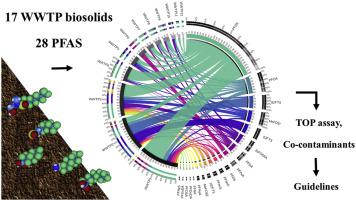Environmental Pollution ( IF 8.9 ) Pub Date : 2020-07-08 , DOI: 10.1016/j.envpol.2020.115120 Julie A Sleep 1 , Albert L Juhasz 1

|
In this study, biosolids from 12 waste water treatment plants across Australia were analysed to quantify the concentration of 28 per- and polyfluoroalkyl substances (PFAS). PFAS concentration varied significantly between locations (5.4–150 g kg-1) while perfluorooctane sulfonic acid (PFOS) was the predominant analyte in 9 of 12 biosolid samples (4.7–86 g kg-1) contributing 17–93% to the total PFAS concentration. However, in WWTP2 and WWTP10, PFAS composition differed significantly, with fluorotelomer sulfonic acids (FTSAs) and perfluorooctane sulfonamide-based substances (FOSAMs), precursor compounds of restricted PFAS, contributing significantly to PFAS concentration. Five additional biosolid samples from historical stockpiles of varying ages located at WWTP3 were analysed to assess changes in PFAS concentration with biosolid age (10–50 years). While temporal trends in PFAS or individual PFAS concentration were not observed, a strong negative correlation was observed between pH and PFAS concentration over a pH range of 4.1–6.6. Three samples (WWTP2, 3 and 10) were selected for further analysis using the total oxidisable precursor (TOP) assay to provide insights into the potential impact of oxidative transformation on individual PFAS concentration. Treatment with persulfate resulted in the decrease of 6:2 and 8:2 FTS (WWTP2), MeFOSE (WWTP2 and 3), EtFOSE (WWTP2), MeFOSAA (WWTP2, 3, 10) and EtFOSAA (WWTP2, 3, 10) with an increase in C4–C9 PFCAs (1–232 g kg-1), while changes in PFSA concentrations were negligible (7 g kg-1). Application of PFAS biosolids international guidance to samples analysed highlighted that 24–88% of biosolids exceeded regulatory standards, although this number increased when precursor compound oxidation was taken into consideration.
中文翻译:

生物固体中的全氟烷基,氟调聚物磺酸盐和全氟辛烷磺酰胺污染:组成,共同污染和重复使用的影响。
在这项研究中,分析了来自澳大利亚12个废水处理厂的生物固体,以量化28种全氟和多氟烷基物质(PFAS)的浓度。不同地点的PFAS浓度差异很大(5.4–150 g kg -1),而全氟辛烷磺酸(PFOS)是12个生物固体样品中9个的主要分析物(4.7-86 g千克-1)占全氟辛烷磺酸总浓度的17–93%。但是,在WWTP2和WWTP10中,PFAS的组成存在显着差异,其中氟代端基磺酸(FTSA)和全氟辛烷磺酰胺基物质(FOSAM)是受限制的PFAS的前体化合物,对PFAS浓度。对位于WWTP3的不同年龄的历史库存中的另外五个生物固体样品进行了分析,以评估PFAS浓度随生物固体年龄(10-50年)而变化。虽然时间趋势在 未观察到PFAS或单个PFAS浓度,在pH和 在4.1–6.6的pH范围内PFAS浓度。选择了三个样品(WWTP2、3和10)进行总可氧化前体(TOP)测定法的进一步分析,以提供有关氧化转化对单个PFAS浓度的潜在影响的见解。过硫酸盐处理导致FTS(WWTP2),MeFOSE(WWTP2和3),EtFOSE(WWTP2),MeFOSAA(WWTP2、3、10)和EtFOSAA(WWTP2、3、10)的6:2和8:2下降C 4 –C 9 PFCA(1-232)的增加 g kg -1),而PFSA浓度的变化可以忽略不计(7 g kg -1)。在分析的样品中应用PFAS生物固体国际指南时,强调了24-88%的生物固体超出了监管标准,尽管考虑到前体化合物的氧化,该数字有所增加。


























 京公网安备 11010802027423号
京公网安备 11010802027423号